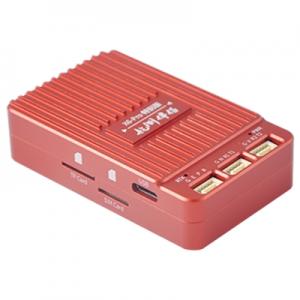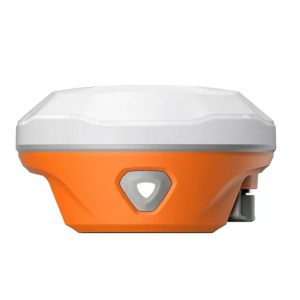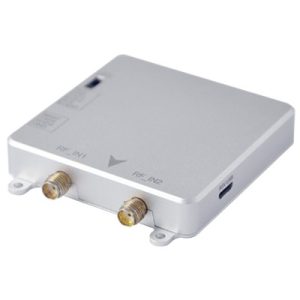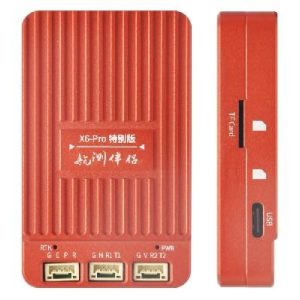Description
RB3 – AsteRx-m3 Pro+ is an advanced GPS/GNSS receiver board that combines Septentrio’s top core GNSS technologies, based upon two decades of innovation. It is designed for high precision and versatility, it offers multi-frequency, multi-constellation GNSS tracking for reliable and accurate navigation. Whether used as a static base station or a mobile rover, the RB3 delivers centimeter-level precision, with the ability to provide heading and pitch or roll data in dual-antenna mode.
This advanced receiver incorporates the AIM+ Advanced Interference Mitigation system, ensuring robust operation even in environments with significant RF interference, such as urban or industrial areas. The GNSS+ suite—including LOCK+, IONO+, and APME+ technologies—further enhances its performance in challenging conditions. LOCK+ maintains satellite tracking during mechanical vibrations or shocks, IONO+ provides unparalleled protection against ionospheric disturbances, and APME+ mitigates multipath errors caused by signal reflections, ensuring consistent accuracy and reliability.
This is optimized for low power consumption, and featuring a minimal Size, Weight, and Power (SWaP) profile, the RB3 is an ideal choice for battery-powered operations, extending runtime and enabling seamless integration into compact devices. Its 100Hz data update rate and top-quality CPU make it perfectly suited for high-accuracy applications requiring rapid response.
The RB3 is user-friendly, with fully documented interfaces and an intuitive web application for configuration, monitoring, and data analysis. The included RxTools software allows for detailed receiver configuration and performance tracking. Its dynamic web interface provides real-time quality indicators, guaranteeing efficient operation and monitoring during any task.
RB3 Specification:
2.1 GNSS Performance
- Product Model: RB3
- GNSS Board: Based on Septentrio AsteRx-m3 Pro+
- Channels: 544 channels
Signal Tracking:
- GPS: L1 C/A, L1C, L2C, L2 P(Y), L5
- GLONASS: L1 C/A, L2C/A, L3, L2P
- BeiDou: B1I, B1C, B2a, B2b, B2I, B3I
- Galileo: E1, E5a, E5b
- QZSS: L1 C/A, L1C/B, L1C, L2C, L5
- SBAS: EGNOS, WAAS, GAGAN, MSAS, SDCM
- Integrated L-band Receiver
Update Rate: 100 Hz
First Positioning Time:
- Cold Start: < 45 seconds
- Warm Start: < 20 seconds
Signal Recapture: Average 1 second
RTK Accuracy:
- Horizontal: 0.6 cm + 0.5 ppm
- Vertical: 1 cm + 1 ppm
Single Point Positioning Accuracy:
Direction Accuracy:
- Antenna Separation:
- 1 m: Heading 0.15°, Pitch/Roll 0.25°
- 5 m: Heading 0.03°, Pitch/Roll 0.05°
SBAS Accuracy:
- Horizontal: 0.6 m
- Vertical: 0.8 m
DGPS Accuracy:
- Horizontal: 0.4 m
- Vertical: 0.7 m
Pseudo-range Accuracy:
Timing Accuracy:
2.2 Data Record
- Storage: Internal memory of 32GB.
- Output Data Format: NMEA0183, RTCM V2.x/V3.2/V3.3, Rinex v3.04/v2.11, and other compatible formats.
- Differential Format: ROX, RTCM2.x, RTCM3.x, CMR, CMR+, with support for proprietary differential formats of optional third-party GNSS OEM boards.
- Network: Supports simultaneous network transmission processes ranging from 2 to 4.
2.3 Interface
- CAN (PWR): M12
- SER: M12
- Ethernet: M12
- UHF: TNC Connector
- GPRS: TNC Connector
- SIM: Micro SIM Supported
- TF Card: Micro TF Card Supported
- GNSS:
- GNSS1: TNC – Main External GNSS Antenna
- GNSS2: TNC – Secondary External GNSS Antenna
2.4 Indicator Description
- Position/Heading Indicator (Red/Green)
- Satellites (Green):
- Green: Fixed solution.
- Flashing Green: Other solution.
- Green Off: No positioning.
- Heading (Red):
- Red: Heading active.
- Red Off: No heading.
- 4G/Bluetooth Indicator (Red/Green)
- Bluetooth (Green):
- Green Off: Bluetooth is disconnected.
- Green On: Bluetooth is connected.
- 4G (Red):
- Flashing Red: Network is abnormal.
- Red On: Network is normal.
- Red Off: 4G is disabled.
- Differential Data Indicator (Red/Green)
- Transmitting Data (Green):
- Solid Green: Data is transmitting over the 4G interface.
- Flashing Green: Data is transmitting over the radio module.
- Receiving Data (Red):
- Solid Red: Data is being received over the 4G interface.
- Flashing Red: Data is being received over the radio module.
2.5 System Overview
- Operating System: Linux A7
- Bluetooth (B/T): BT 5.0 EDR with downward compatibility and LE support
- Wi-Fi: Supports 802.11b/g
- 4G: LTE Full Netcom communication module
- Ethernet: 100M Ethernet capability
- UHF:
- Model: TRM101 HDSC
- Function: TX/RX data transmission transceiver
- TX Power: 1 Watt
- Frequency Range: 410 MHz – 470 MHz
2.6 Network Features
NTRIP Caster/Server/Client
- Supports onsite management.
- Includes features like Bluetooth settings, serial port configuration, and WiFi settings, all manageable through Android apps.
Remote Management
- Offers configuration via a web page.
- Includes a dedicated remote management software for the device.
Network Management
- Provides network connection capabilities such as intranet penetration, VPN, OpenVPN, and dynamic domain name support.
Safety Features
- Supports HTTP and HTTPS/SSL for secure logins.
- Includes NTRIP and IP filtering functionalities.
- Requires additional information (e.g., name) during WEBUI login, records user operations, and tracks username and password usage.
- Defines user roles, including developer rights, administrator rights, user views, and guest access.
2.7 Other
- Environment
- Working Temperature: -40°C to +80°C
- Storage Temperature: -45°C to +85°C
- Humidity: Anti-condensing up to 100%
- Input: +7V to +36V DC
- Protection: IP67
- Drop Test: In room temperature, 1.5m free drop onto concrete ground
- Weight: *KG
- Dimensions:
- Bare Receiver: Lmm × Wmm × H*mm
- Complete Receiver: Lmm × Wmm × H*mm
- Cabinet Receiver: Lmm × Wmm × H*mm
- Electrical Specification
- Power Consumption: 5W
- Input Voltage: Directly connected to the power source
RB3 ( Aste-m3 Pro+ ) Features:
- Multi-frequency, multi-constellation GNSS tracking: Aste-m3 ensures top-notch positioning accuracy.
- Dual antenna mode: Our RB3 provides precise heading and pitch or roll data.
- AIM+ Advanced Interference Mitigation: Protects against jamming and spoofing.
- GNSS+ Technologies: Includes LOCK+ for vibration resistance, IONO+ for ionospheric interference protection, and APME+ for multipath mitigation.
- High-performance CPU: RB3 supports 100Hz data update rates for real-time applications.
- Optimized SWaP: It’s compact design offers industry-leading power efficiency.
Surveying and Mapping: It obtain high-precision positioning in challenging & testing terrains.
Agriculture: Use reliable GNSS guidance to enable precision farming.
Robotics: Enhance navigation with robust anti-interference technology.
Construction: It provide precise positioning and ensure accurate machine control and equipment tracking.
Autonomous Vehicles: Assist reliable positioning for UAVs, UGVs, and maritime vessels.
Scientific Research: Make it easier to take precise measurements in various environmental conditions.
What is the difference between base station and rover mode?
Base station mode refers to a stationary receiver providing correction data to improve the accuracy of a moving rover receiver. Rover mode is used for mobile operations, calculating positions with high precision.
How does AIM+ mitigate interference?
AIM+ leverages advanced sampling and mitigation mechanisms to detect and counteract jamming and spoofing, ensuring uninterrupted GNSS signal reception.
What is the benefit of GNSS+ technologies?
GNSS+ technologies like LOCK+, IONO+, and APME+ enhance the receiver’s performance in environments with vibrations, ionospheric disturbances, or signal reflections, ensuring consistent accuracy.
How energy-efficient is the RB3 – AsteRx-m3 Pro+?
The RB3 is optimized for low power consumption, enabling extended operation on a single battery charge, making it ideal for field applications.
Can the RB3 be integrated into custom systems?
Yes, its compact design and versatile interfaces allow seamless integration into various custom platforms, including UAVs, autonomous vehicles, and industrial equipment.








